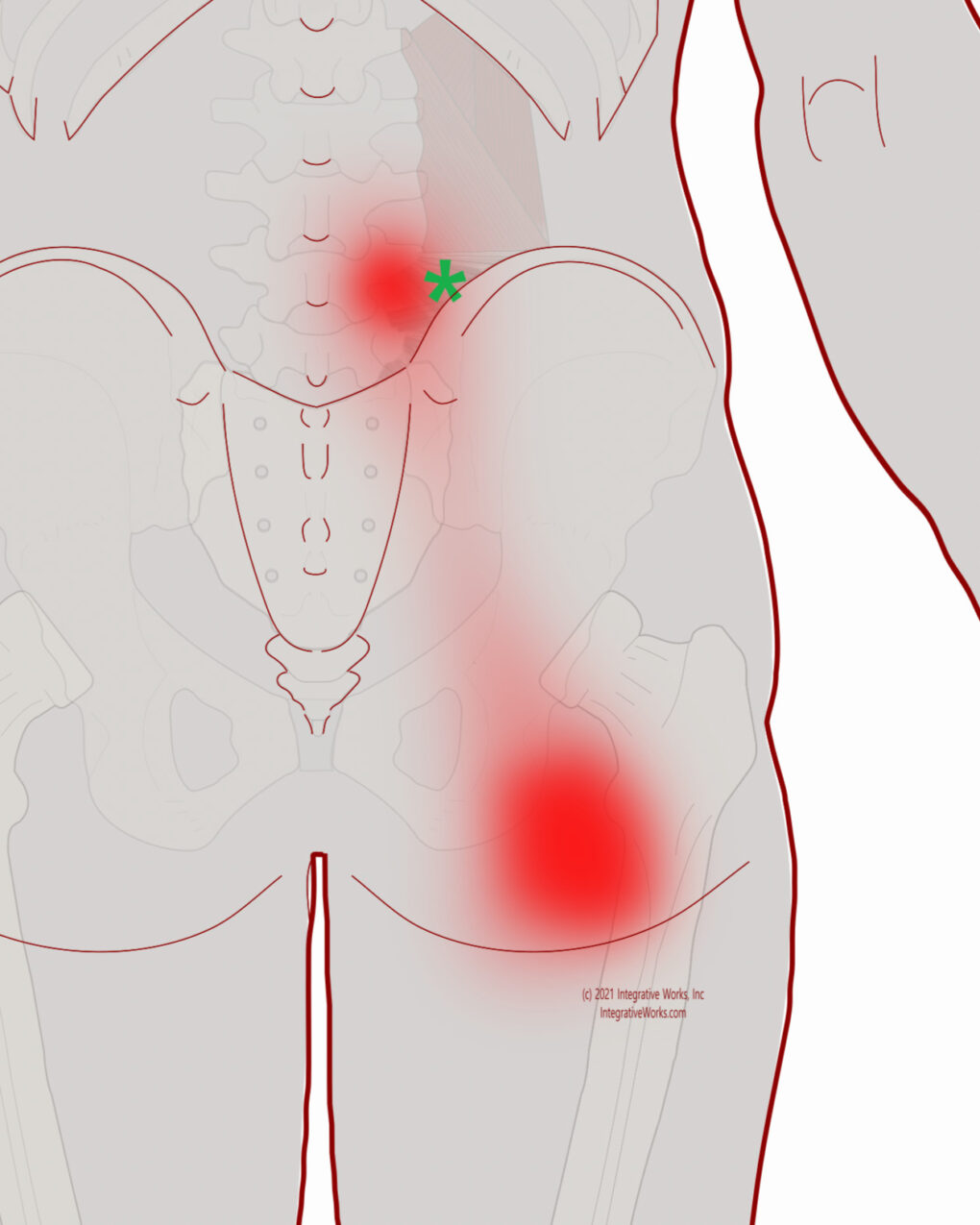Stiff Low Back with Pain in the Lower Buttock
Table of Contents
- How People Describe This Pain Pattern
- How You Activate and Intensify This Pain Pattern
- Self-Care – Getting Relief on Your Own
- Musculoskeletal Anatomy Behind Your Pain
- Therapy Notes for Massage and Bodywork
Overview
This is one of several posts about a stiff, fragile low back. This particular pattern also involves pain in the lower buttock. A stiff low back is usually a combination of a binding intervertebral joint with more than one muscle involved. If you have a stiff low back, you should compare these posts.
How People Describe This Pain Pattern


These people complain of stiffness at the base of their low back. Additionally, they may press into the fleshy part of the lower buttock and say that it hurts there.
Typically, one of the focuses is a primary complaint that is more aggravating. Some people primarily complain of notable pain in the low back with some hip soreness. Conversely, others primarily complain of an achy buttock with some stiffness at the base of the spine.
Low Back Stiffness
Often, with stiffness in the base of the spine, they have noticed some tenderness when they press into their back just above the dimple in their hip. Occasionally, this area is sharp, fragile and debilitatingly painful.
Buttock Pain
The hip pain can be sudden, sharp, dull, and achy. These people are fidgety and adjust their seating to try to get relief. The pain in the hip can be sharp when it twists unexpectedly. Older people are concerned about their hip joint and may have recently had an orthopedist check their hip for pain, only to have the doctor say that their hip is just fine.
How You Activate and Intensify This Pain Pattern
Leaning, Teetering, Picking Things Up
Like other QL problems, this condition is usually activated by a teetering activity like sweeping, mowing the grass, moving boxes, or washing dishes. It is also activated by leaning forward and reaching out. For example, this stiff low back and/or lower buttock pain may flare up after stacking things in the back of a low cabinet.
The Musculoskeletal Anatomy Behind Your Pain
Musculoskeletal Anatomy
This post on anatomy contains standard information about the origin, insertion, function, and innervation of muscles. Additionally, it includes information on functional considerations and anomalies.
Find Related Posts
Anatomy posts have a grid of all related posts. This includes posts on pain patterns, self-care, therapy notes, NMT protocols, cranial techniques, and cases.
Getting Relief on Your Own
Clinically Proven
Self-Care Strategies
Self-Care Posts have common sections to make them easy to follow and understand:
- Activities to Avoid or Change
- Strategies for Quick Relief
- Stretches and Exercise for Longer-Lasting Relief
- Yoga Corner
Therapy Notes for Massage and Bodywork
Better Bodywork
Through Shared Expertise
Therapy Notes provide details for cranial, spinal, and local joint work. These notes also link to a traditional neuromuscular protocol.
By treating integrative components first, direct work on the muscle becomes less intense while providing longer-lasting relief.
Support Integrative Works to
stay independent
and produce great content.
You can subscribe to our community on Patreon. You will get links to free content and access to exclusive content not seen on this site. In addition, we will be posting anatomy illustrations, treatment notes, and sections from our manuals not found on this site. Thank you so much for being so supportive.
Cranio Cradle Cup
This mug has classic, colorful illustrations of the craniosacral system and vault hold #3. It makes a great gift and conversation piece.
Tony Preston has a practice in Atlanta, Georgia, where he sees clients. He has written materials and instructed classes since the mid-90s. This includes anatomy, trigger points, cranial, and neuromuscular.
Question? Comment? Typo?
integrativeworks@gmail.com
Follow us on Instagram
*This site is undergoing significant changes. We are reformatting and expanding the posts to make them easier to read. The result will also be more accessible and include more patterns with better self-care. Meanwhile, there may be formatting, content presentation, and readability inconsistencies. Until we get older posts updated, please excuse our mess.